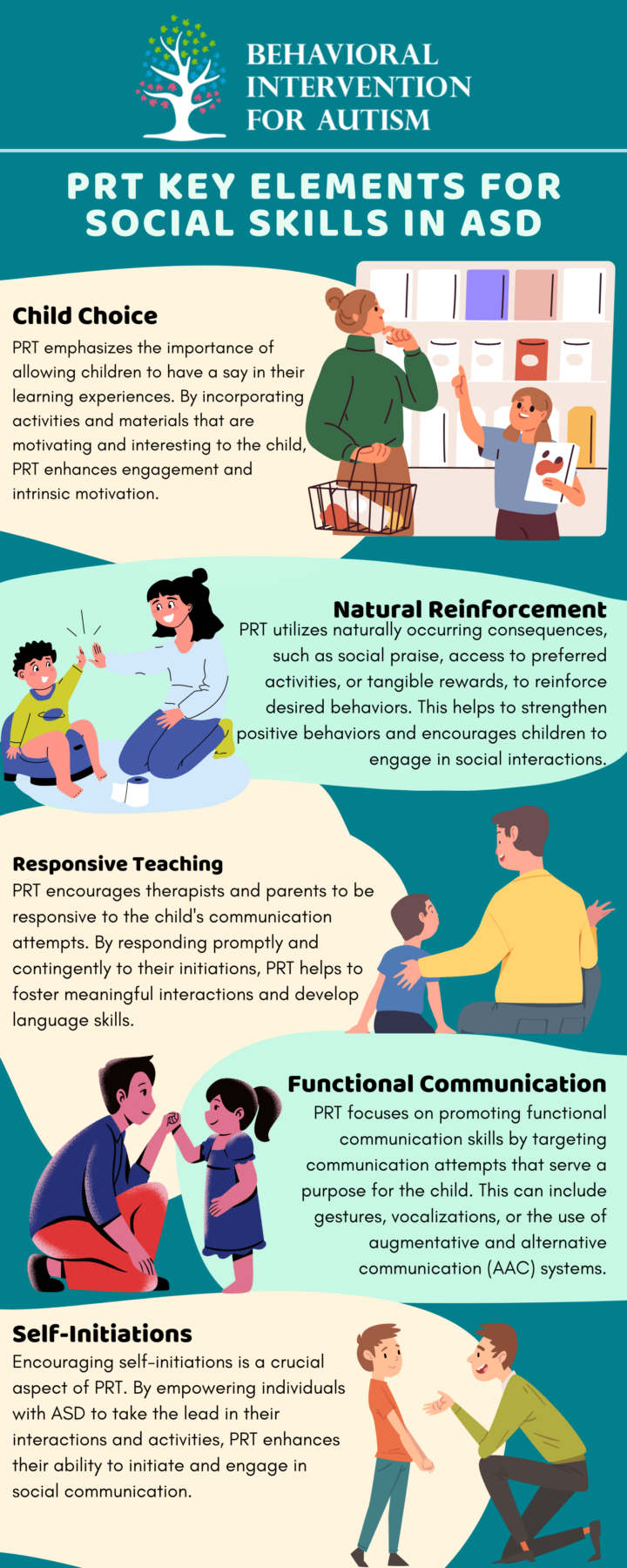
Table of Contents
To effectively address the unique challenges faced by individuals with autism spectrum disorders (ASD), various therapeutic approaches have been developed. One such evidence-based behavioral therapy is Pivotal Response Treatment (PRT). We will delve into an overview of PRT and examine its fundamental elements.
introduction to prt
Pivotal Response Treatment (PRT) is a behavioral therapy that aims to help individuals with ASD develop important social skills by targeting four pivotal areas: responding to multiple cues, motivation, initiation, and self-management. Unlike traditional behavioral interventions, PRT focuses on pivotal areas of a child’s development rather than specific behaviors. This approach allows for enhancements in social interactions, behaviors, and communication, leading to more comprehensive progress.
PRT is a naturalistic and child-centered intervention that encourages children to take an active role in their learning process. By harnessing intrinsic motivation, PRT creates opportunities for children to engage in activities they prefer, leading to increased interest and participation. This approach promotes the generalization of skills across different settings and individuals.
key components of prt
PRT incorporates several key components to facilitate the development of social communication skills in individuals with ASD which are as follows:

Targeting these pivotal areas, PRT aims to enhance social communication skills, language development, and reduce disruptive behaviors in individuals with ASD. Its child-centered approach and focus on intrinsic motivation make PRT a promising intervention for individuals on the autism spectrum.
contrasting prt and aba
In the realm of autism spectrum disorder (ASD) interventions, two prominent behavioral therapies are Pivotal Response Treatment (PRT) and Applied Behavioral Analysis (ABA). While both approaches share some similarities, they differ in their specific focus and methodology.
focus of prt
PRT uses a holistic approach to address core deficits in ASD. This method aims to improve social communication and interaction skills while empowering individuals to actively participate in their learning. By integrating meaningful and enjoyable activities, PRT boosts engagement and fosters skill development through intrinsic motivation.
differentiation from aba
While ABA and PRT both fall under the umbrella of behavioral therapies, there are distinct differences between the two approaches. ABA traditionally focuses on specific behavioral targets and utilizes detailed behavior plans to shape and reinforce desired behaviors. It often involves breaking down skills into smaller, manageable steps and uses prompting and prompting fading techniques to guide individuals toward the desired behavior.
In contrast, PRT takes a more naturalistic approach, integrating learning opportunities into the individual’s daily life. PRT reinforces not only the desired behavior but also any valid attempts the individual makes toward the desired behavior. This approach increases the frequency of reinforcement and keeps the individual motivated throughout the treatment process.
Another key difference is that ABA tends to have a more structured teaching format, while PRT allows for flexibility and individualization. PRT focuses on the individual’s interests and preferences, tailoring the interventions to meet their specific needs and goals. This personalized approach can enhance motivation and engagement, leading to more meaningful and effective outcomes.
Understanding the distinctions between PRT and ABA helps parents, caregivers, and individuals with ASD make informed decisions about which approach best aligns with their goals and preferences. Both therapies have proven effective in enhancing social communication, and language skills, and reducing disruptive behaviors in individuals with ASD. Consulting with professionals and considering the unique needs of the individual are crucial in determining the most appropriate intervention approach.
effectiveness of prt for asd
Pivotal Response Treatment (PRT) has shown promising results in improving the lives of individuals with autism spectrum disorders (ASD). This evidence-based behavioral therapy focuses on targeting pivotal areas of development, leading to improvements in social communication and a reduction in disruptive behaviors.
improvements in social communication
PRT aims to enhance social communication skills in individuals with ASD by using naturalistic teaching strategies. It encourages engagement in motivating activities, leveraging intrinsic motivation to foster social interaction and language development. By reinforcing desired behaviors and attempts, PRT keeps individuals motivated and can lead to significant improvements in language use, pragmatic skills, and social interactions. This approach helps generalize skills across various social contexts for more effective communication.
reduction of disruptive behaviors
PRT not only enhances social communication skills but also reduces disruptive behaviors in individuals with ASD. By targeting key developmental areas and promoting self-management, PRT uses positive reinforcement in a supportive environment to encourage appropriate behaviors and offer alternatives to challenging ones.
Research studies have shown that PRT can lead to a reduction in disruptive behaviors such as tantrums, aggression, self-injurious behaviors, and stereotypic behaviors. The emphasis on intrinsic motivation and the individualization of treatment in PRT allows for a tailored approach that addresses the unique needs of each individual, leading to more effective behavior management.
Focusing on the pivotal areas of development and targeting social communication skills, PRT has demonstrated promise in enhancing the lives of individuals with ASD. The individualized nature of PRT, combined with its emphasis on motivation and positive reinforcement, establishes an empowering and effective treatment approach for individuals with autism spectrum disorders.

tailoring prt for individuals
Pivotal Response Treatment (PRT) for Autism Spectrum Disorders offers a flexible approach that can be tailored to the unique needs and skill set of each individual. This individualization allows for a more personalized treatment plan, ensuring that the intervention is effective and meaningful for the person with autism.
individualization of treatment
PRT recognizes that each individual with autism is unique, with different strengths, challenges, and interests. As such, the treatment is adapted to meet the specific needs of the individual. This means that the goals, strategies, and motivators used in PRT are tailored to the individual’s abilities and preferences.
For example, PRT can be used to help individuals of all ages, from infancy through adulthood. The motivators used in PRT are individually selected based on the person’s interests, such as games, conversations, activities, or outings. By incorporating activities that are personally meaningful to the individual, PRT increases their motivation to engage with others, communicate, and learn.
delivery by parents and therapists
One of the unique aspects of PRT is that it can be delivered not only by therapists but also by parents, teachers, and other caregivers. Parent group-delivered PRT is effective in improving children’s social communication skills and empowering families.
Parents play a crucial role in PRT, as they are involved in the treatment process and receive support and guidance from therapists. They learn how to implement PRT strategies and techniques in their everyday interactions with their child. While not every interaction needs to be PRT-based, parents are encouraged to consistently incorporate PRT principles into their interactions, as this approach works best when used consistently.
Therapists also play an important role in PRT. They provide guidance, training, and ongoing support to parents and caregivers, helping them develop the necessary skills to implement PRT effectively. Therapists work closely with the family to ensure that treatment goals are individualized and progress is monitored.
Involving parents and therapists in PRT makes treatment more comprehensive and accessible. This approach empowers parents to actively engage in their child’s intervention, fostering a collaborative environment that boosts social and communication development. By tailoring the treatment to individual needs and allowing for delivery by various caregivers, PRT enhances its effectiveness and supports the child’s growth.
success rates and studies
Success rates for pivotal response treatment (PRT) in individuals with autism spectrum disorders (ASD) vary based on several factors, including the individual’s unique needs and the quality of treatment implementation. Research has demonstrated that while PRT can be highly effective, outcomes are influenced by these variables. Examining the success rates and the supporting studies provides insight into the efficacy of PRT and its application in different contexts.
varied success rates
Estimates of success rates in PRT can vary widely across studies. Different research studies have reported success rates ranging from 2% to 47% of individuals achieving an optimal outcome. These rates highlight the individual variability in how individuals with ASD respond to PRT. It’s important to note that success rates can also be influenced by factors such as the duration of treatment, the intensity of intervention, and the age at which PRT is initiated.
studies supporting prt efficacy
Numerous studies have been conducted to evaluate the efficacy of PRT in improving social communication skills and reducing disruptive behaviors in individuals with ASD. These studies provide evidence supporting the effectiveness of PRT as an intervention for individuals on the autism spectrum.
For example, a study by Sherer and Schreibman compared the baseline profiles of children with ASD who received PRT. The study found that responders to PRT demonstrated greater engagement in functional, symbolic, and varied play at baseline. Throughout these individuals experienced improvements in these areas, further supporting the efficacy of PRT in enhancing social communication skills.
Advancements in PRT now use neuroimaging and behavioral measures to identify objective biomarkers of treatment response. Research supports PRT’s positive impact on social communication and reduction of disruptive behaviors in individuals with ASD. Ongoing research will further refine its effectiveness and inform tailored treatments.
advancements in prt
As the field of autism treatment continues to evolve, pivotal response treatment (PRT) has seen significant advancements that enhance its effectiveness and provide a deeper understanding of its mechanisms. Two notable advancements in PRT are the integration of neuroimaging techniques and the use of biomarkers for response prediction.
integration of neuroimaging
Recent advancements in PRT have increasingly integrated neuroimaging techniques to gain insights into the neurological changes that occur during treatment. Neuroimaging, such as functional magnetic resonance imaging (fMRI) and electroencephalography (EEG), allows researchers to study brain activity and connectivity patterns associated with PRT.
Neuroimaging techniques offer valuable insights into how PRT induces changes in brain function and connectivity. These objective measures enhance our understanding of the neural mechanisms behind the observed improvements in individuals with autism spectrum disorders (ASD) undergoing PRT. Studies utilizing neuroimaging have revealed distinct neural profiles in response to biological motion at baseline, which can predict treatment gains in social competency following PRT in children with ASD.
biomarkers and response prediction
In addition to neuroimaging, advancements in PRT have also explored the use of biomarkers to predict treatment response. Biomarkers are objective measures, such as behavioral or physiological markers, that can help identify individuals who are more likely to respond positively to PRT.
Analyzing biomarkers offers practitioners valuable insights into individual differences, allowing for the customization of treatment plans. These biomarkers can predict responder profiles, enabling therapists to tailor PRT interventions to meet each individual’s specific needs. This personalized approach enhances the effectiveness of PRT and leads to improved outcomes for individuals with ASD.
These advancements in the integration of neuroimaging and biomarkers provide a more comprehensive understanding of the underlying mechanisms of PRT and its impact on individuals with autism. They contribute to the ongoing refinement and optimization of PRT interventions, ultimately leading to better outcomes for individuals on the autism spectrum.
As research in this field continues, we anticipate further advancements that will enhance our understanding of PRT and its potential to drive meaningful progress for individuals with autism spectrum disorders.
Behavioral Intervention for Autism provides top-quality ABA therapy in Florida, tailored to meet your unique needs. Our dedicated team delivers personalized care that supports development and growth.
For more information or to schedule a consultation, contact us today and discover how we can help make a positive impact.
- 9 Common Obsessions of Children With Autism You Should Know - February 25, 2025
- What is Neurodiversity? A Guide to Embracing Differences - February 25, 2025
- Understanding Hyperfocus in Autism: What It Means and Why It Happens - February 25, 2025
